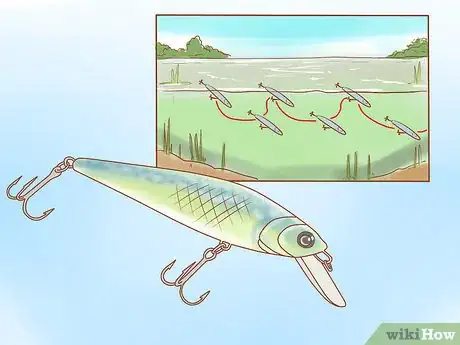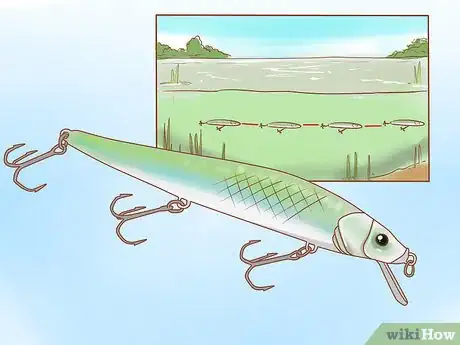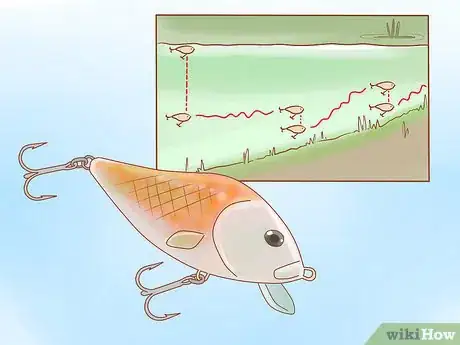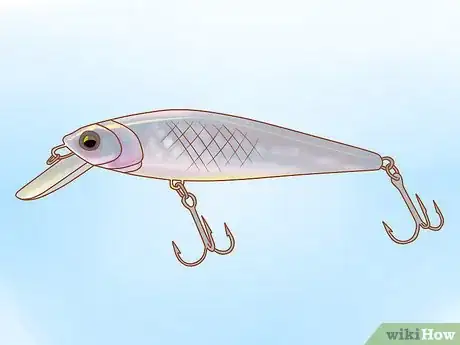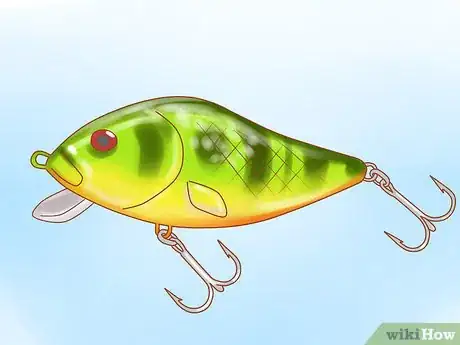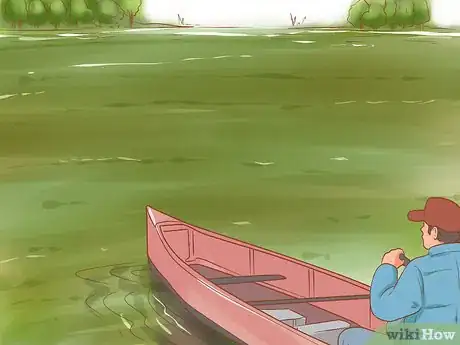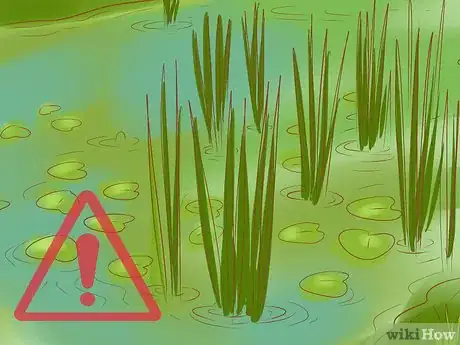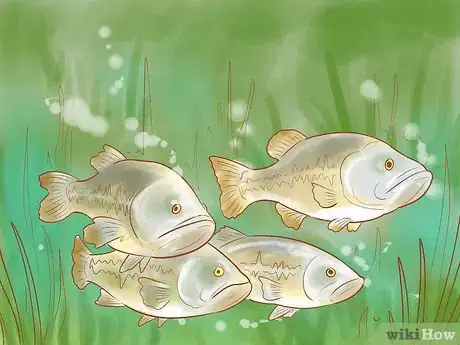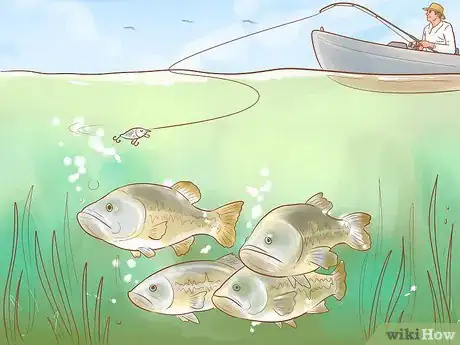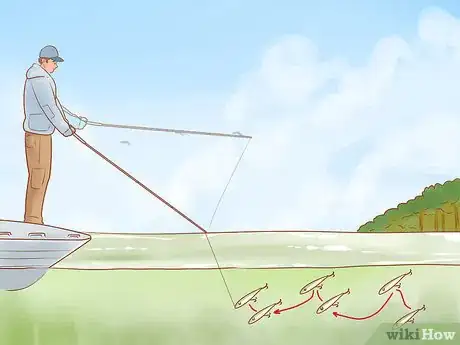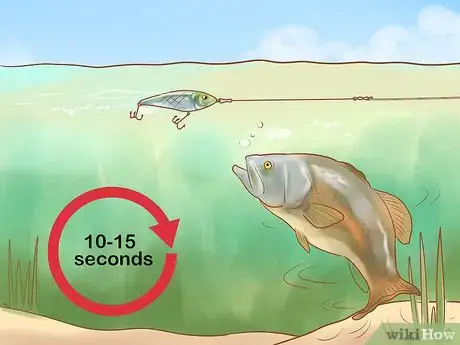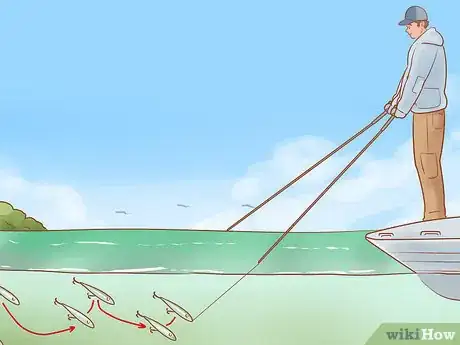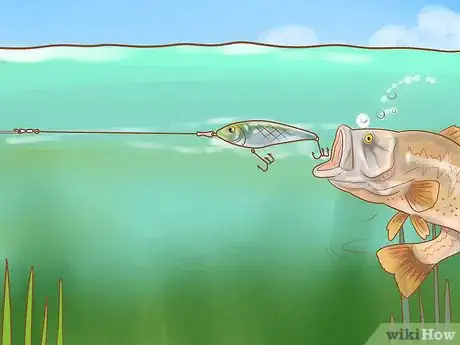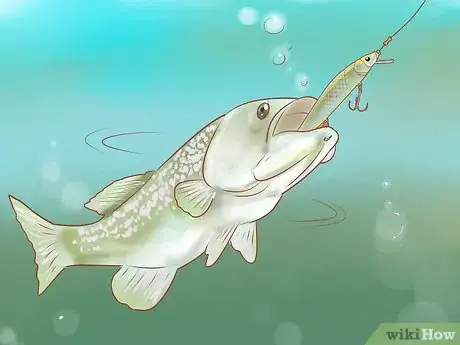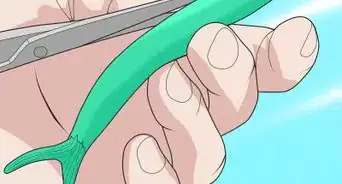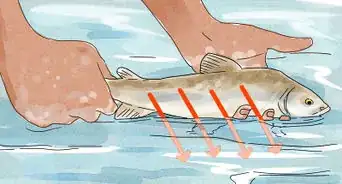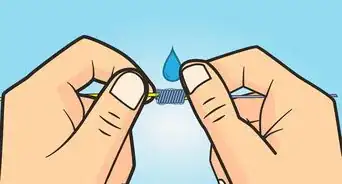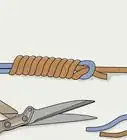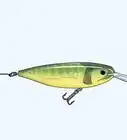This article was co-authored by wikiHow Staff. Our trained team of editors and researchers validate articles for accuracy and comprehensiveness. wikiHow's Content Management Team carefully monitors the work from our editorial staff to ensure that each article is backed by trusted research and meets our high quality standards.
This article has been viewed 35,992 times.
Learn more...
The jerkbait is a small, hard bait used to fish for bass. The bait has been designed to move like a struggling minnow, which will make the predatory bass react and strike at the bait. Jerkbaits are long and narrow, usually between 3–6 inches (7.6–15.2 cm), and have 3 treble hooks dangling from their underside and tail. These baits also have a bill protruding from the front of the bait which makes the fish dive when an angler reels it fast or jerks hard on the line. As the name indicates, when an angler reels a jerkbait back in, they can make it twitch and dive in the water by jerking on the line.
Steps
Choosing a Style and Color of Jerkbait
-
1Fish a floating jerkbait if you’re a beginner. As the name suggests, floating jerkbaits do not sink into the water until they’re jerked. So, it’s very unlikely that a floating jerkbait will get snarled up in weeds, shrubs, or obstacles under the water.
- Floating jerkbaits are also great for catching bass in the top 3 feet (0.91 m) of water.
-
2Opt for suspending jerkbaits to fish at a specific depth. Suspending jerkbaits comprise the most common category of jerkbaits. This style of jerkbait will sink to a specific depth in the water and then remain suspended at that depth. Even when you jerk the bait, it will return to its specified suspension depth. This is useful when you’re trying to catch bass a certain depth below the surface of the water.
- For example, some suspending jerkbaits are designed to sink only to about 4 feet (1.2 m), while others sink as deep as 10 feet (3.0 m).
- Try a few different depths of suspending baits to find which works best at your local lake.
Advertisement -
3Experiment with sinking jerkbaits to catch bass deep in a lake. Once you’ve gained some experience fishing with floating jerkbaits, use can move on to more demanding sinking baits. These baits are weighted down so that they’ll sink at a certain speed and then rise up when jerked. Different sinking baits contain different amounts of weight so they’ll sink at different rates. Try a few different weights to find out which works best for your current fishing conditions.
- For example, if you’re fishing in summer and bass are hiding out deep in the lake, a fast-sinking jerkbait will take your bait to the fish more quickly than a slow-sinking bait.
-
4Start out with a natural-colored jerkbait to lure in bass in clear water. Jerkbaits come in a variety of colors, ranging from natural minnow shades (greens, blues, and silvers) to more artificial colors (reds, golds, and oranges). In clear water, bass will see the colors clearly and will be inclined to strike natural-colored baits that look like actual minnows. So, start out with a semi-translucent, natural-colored bait.[1]
- Jerkbait fishing often works best when you have a variety of jerkbaits to experiment with. Before your fishing expedition, visit your local fishing store or sporting goods store and pick out 5-7 different jerkbaits.
-
5Try an artificial-colored jerkbait to attract bass in clouded water. In slightly clouded water, bass won’t be able to see the colors of the bait as clearly. In fact, a bright chartreuse bait may draw the attention of bass in clouded water better than a natural-colored bait would. So, break out the bright colors when fishing in clouded water.[2]
- Alternately, if the bass just aren’t striking at your natural color baits in clear water, switch things up and use an artificial-colored bait. Fish can be finicky, and what color or jerkbait they strike may vary from day to day.
- Also fish with artificial-colored jerkbaits in summer. The bright colors will catch the fish’s eye. Since bass are more energetic in summer, they’ll come investigate the bait.
Finding Ideal Conditions to Fish a Jerkbait
-
1Fish your jerkbait in cold, static water. Jerkbait are designed to mimic the movements of wounded baitfish (e.g., minnows) in very cold water. Bass are aware of how these slow, stunned minnows move, and will be mostly likely to strike at your jerkbait in cold water. So, use a jerkbait for spring (or ice-free winter) fishing.
- However, jerkbaits versatile enough that they’ll do a decent job in most seasons. If you’re fishing a jerkbait in warm summer water, shorten the length of your pauses to give warm, active bass more of a chase.
- Jerkbait would not be an effective bait in a moving stream or river. Only use them in static water like lakes or reservoirs.
-
2Use the jerkbait in clear, unclouded freshwater. Since the bait will be sitting motionless for a good portion of its time in the water, bass need to be able to see it clearly. Unlike other types of bass baits, the jerkbait doesn’t flash sunlight out into the surrounding water. So, it’s best to fish in water that’s clear to a depth of at least 2 feet (0.61 m). Trawl around your local lake until you find a clear patch, and cast there.[3]
- This way, a hungry bass will be able to see (and may strike!) the jerkbait through several vertical feet of water.
-
3Try the jerkbait in open, vegetation-free water. Fishing for bass with a jerkbait works best over open water, where there’s no chance of the bait being caught in underwater vegetation. This is because the jerkbait is a relatively delicate bait with relatively small hooks. If you’re fighting a large bass through dense vegetation, the fish will most likely get away.[4]
- So, avoid casting the jerkbait near shores or ledges, where you’re likely to find underwater grass, shrubs, and stumps.
-
4Cast over bass in deep underwater channels. During the heat of the day, bass love to congregate in large schools in underwater channels. These can occur in natural or man-made lakes and reservoirs. In clear water, you should be able to look down and see where channels occur. If you see bass in the water, cast your jerkbait over the school and reel it in.[5]
- With a jerkbait, you’re better off sticking to water that’s at least 10 feet (3.0 m) deep. Stay out of the shallows unless you want to risk losing your bait among dense underwater vegetation.
Reeling in the Jerkbait
-
1Cast the jerkbait over the area you’d like to fish. Once you’ve found a patch of clear water, cast out your line. Hold your rod out to either the right or left side of your body with about 1 foot (0.30 m) of line dangling off the front. Keep your thumb on the reel spool. Then, in a quick, fluid motion, swing the rod straight out in front of you. When the rod is directly in front of your body, take your thumb off the reel spool and let the line fly out.
- Aim to cast the bait about 40 feet (12 m), so it soars over the clear-water area you’d like to fish. Then you’ll be prepared to reel the jerkbait back over the area that bass may inhabit.
-
2Cast with your jerkbait if you’re chasing a school of bass. Bass in schools tend to be more aggressive hunters. If you’re fishing in clear water, the school will be able to see your bait from many feet off. This means that you may have an entire school of bass chasing and trying to strike at your bait. If you cast your jerkbait over (or near) a school of bass, they should show interest and strike the bait.[6]
- If you’re trawling around a clear lake and happen to see a school of bass, start fishing with your jerkbait.
-
3Jerk the line downward to make the jerkbait dive in the water. Once you’ve cast, hold your rod straight out from your body. To jerk the bait, dip the tip of the rod sharply down. This will yank the jerkbait forward and downward by about 1 foot (0.30 m) in the water. To help with the motion, visualize the hands of a clock. Start with the rod at the 3 o’clock position, and jerk it downward to the 5 o’clock position.
- Due to the design of the jerkbait’s bill, it will dip down in the water when yanked. This should attract bass that are deep below the water’s surface.
-
4Let the jerkbait sit for 10-15 seconds. Once you’ve jerked the bait, let the bait sit static in the water. This period of rest will mimic a cold minnow at rest and should cause bass to strike.
- You can let the bait sit in the water for a longer duration if bass aren’t biting during the 10-15-second pauses. Play around with the timing of your pauses and see what’s most effective for luring in bass.
- For example, in cold weather, fish may be more responsive if you let the bait sit in the water for 30 seconds.
-
5Give the line 2 more hard jerks. As before, dip the tip of your rod sharply downward to jerk the bait. Give the line 2 hard jerks spaced about 5 seconds apart. Jerking on the line twice in a row will make the jerkbait dive deeper than before and make its movements appear more sporadic to deep-diving bass.
- The quick dives and long rests of the jerkbait will make the bass think that the minnow (your jerkbait) is stunned by the cold water and can’t move properly.
- For actual minnows, this occurs when the water in a lake gets down to about 40 °F (4 °C).
-
6Let the bait sit for another 20-30 seconds. Remember to be patient during these times when you’re letting the bait rest in the water. It may seem like a waste of time, but in fact it’s during this rest that bass in the lake are most likely to strike your bait.[7]
- If you find yourself getting impatient and wanting to reel in the bait before 30 seconds have passed, use the second hand on your watch to time the rest.
-
7Repeat the process until you’ve drawn the bait in. Continue jerking the line, letting it rest, jerking it twice more, and reeling it in between jerks. Eventually, you’ll have reeled the jerkbait all the way back to the tip of your rod. At this point, begin the process over again: cast out the jerkbait and alternate jerking the bait and letting it rest.
- After you’ve fished over a patch of water 4-5 times, change your location and try the spot from a different angle. Or move to a different spot altogether.
-
8Hook a bass once it’s struck the bait 2 or 3 times. Since jerkbaits have 3 treble hooks on them, you’ll hook a bass most effectively if it has at least 2 of the hooks in its mouth. A bass usually won’t get the bait deep into its mouth on the first strike. As soon as you feel a firm second strike, sharply jerk the rod 45° to the right or left to catch the hooks in the bass’s jaw.
- Once you’ve hooked the bass, 2 or all 3 of the treble hooks should be embedded deep in the fish’s mouth.
-
9Reel the bass in as it’s wearing itself out. If you start reeling too quickly once you’ve hooked your fish, it may slip off of the bait or snap your line. If the bass is flailing around in the water and you’re concerned that the line may break, let out another 1–2 feet (0.30–0.61 m). Then, once the bass has tired itself out and takes a break from thrashing, reel in as much line as you can. Fight the bass and keep reeling it in until you’ve landed the fish.
- Reeling in a large bass can be a long, intense battle, so be sure to pace yourself.[8]
References
- ↑ https://scout.com/outdoors/bass-fishing/Article/Why-You-Need-to-Fish-Jerkbaits-in-the-Summer-for-Bass-101451618/
- ↑ https://scout.com/outdoors/bass-fishing/Article/Why-You-Need-to-Fish-Jerkbaits-in-the-Summer-for-Bass-101451618/
- ↑ https://www.youtube.com/watch?v=HqbkDwDUuM4&feature=youtu.be&t=34s
- ↑ http://www.bassdozer.com/articles/crawford/jerkbait.shtml
- ↑ https://scout.com/outdoors/bass-fishing/Article/Unconventional-Coldwater-Jerkbait-Tips-105347345/
- ↑ https://www.youtube.com/watch?v=HqbkDwDUuM4&feature=youtu.be&t=1m19s
- ↑ https://scout.com/outdoors/bass-fishing/Article/A-Year-Round-Guide-to-Floating-Jerkbaits-101451927/
- ↑ https://scout.com/outdoors/bass-fishing/Article/Unconventional-Coldwater-Jerkbait-Tips-105347345/
